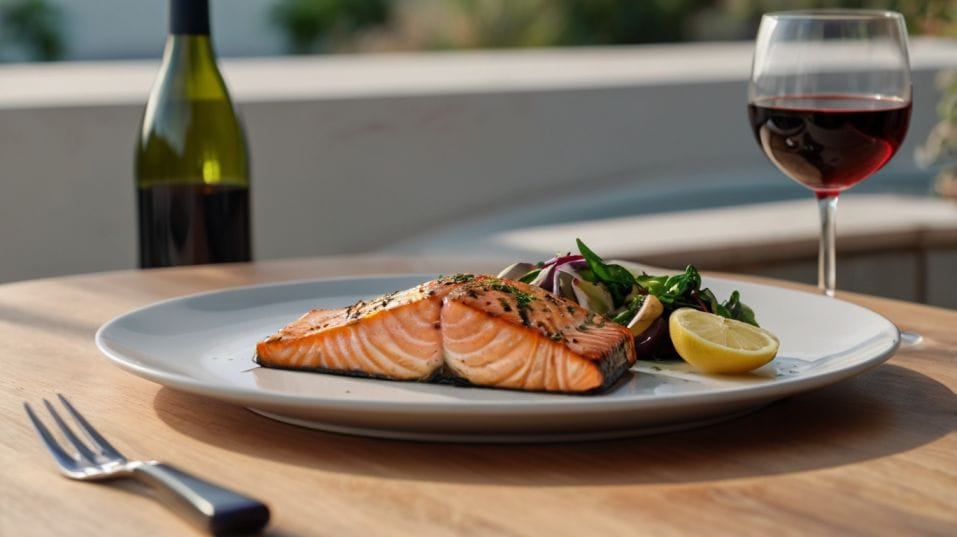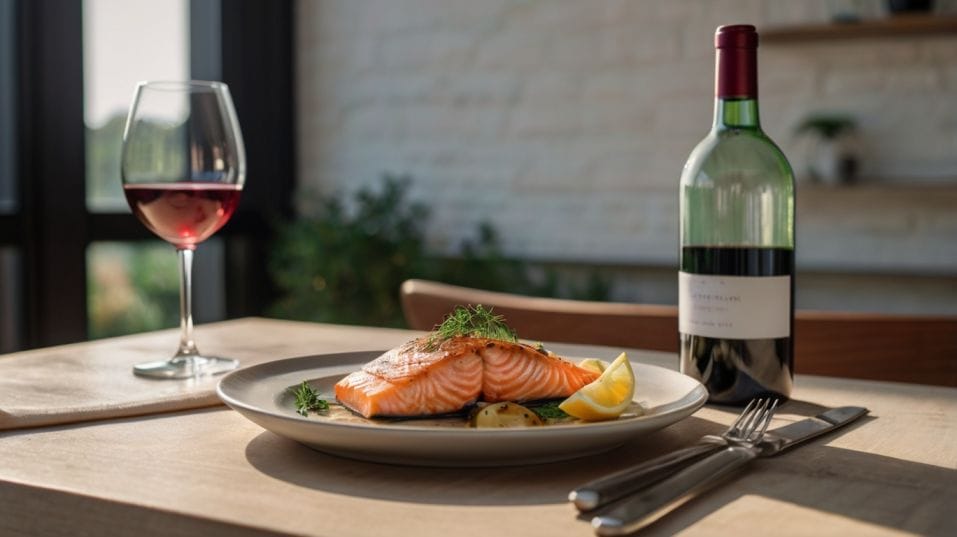Red Wine with Fish? Here’s When It Works
Think red wine doesn’t pair with fish? Think again. Discover how to match flavors, textures, and styles—no matter your wine level.

Can red wine really work with fish—or is that just wine-snob myth? If you’re early in your wine journey, this question marks a turning point.
Because the answer opens up more than new pairings—it unlocks a whole new way of thinking. It’s not about memorizing rules.
It’s about recognizing texture, tuning flavor, and making confident choices. Yes, red wine can transform seafood. You just have to know when.
Why the Rule Exists (and When It Falls Apart)
Most red wines contain tannins—naturally occurring compounds that give structure, bitterness, and a drying sensation. Tannins are great with steak.
They grip fat, cleanse the palate, and make rich food feel balanced. But with delicate white fish? Tannins can make the wine taste metallic or flat and exaggerate any bitterness in the food. That’s the root of the old rule.
But not all fish are delicate. Not all red wines are tannic. And the way a dish is cooked changes the game.
When texture, flavor intensity, and acidity line up, red wine can enhance a seafood dish in ways white wine sometimes can’t. So if you know what to look for—and what to avoid—you unlock a whole new range of pairings.

Texture Over Type: Rethinking “Red vs. White”
Start with texture. A thick-cut, grilled tuna steak has more in common with a medium-rare filet than it does with a poached tilapia.
It’s dense, fatty, and robust. That’s the kind of fish that welcomes a red wine—especially one that’s light-bodied, high in acidity, and smooth in structure.
Think of wines like Pinot Noir, Gamay, Frappato, or even lighter Syrah from cooler regions. These are reds that behave with finesse, not force.
Their fruit, earth, and acid can complement the savory depth of grilled or roasted fish without creating tension on your palate.
On the flip side, delicate fish—flounder, sole, cod—can easily be overwhelmed by even the softest red. Their texture is too fine.
Their flavor is too subtle. With those, stick to whites, rosés, or skin-contact wines that echo their lightness without drowning them out.
Acidity: The Secret to Balance
When in doubt, focus on acidity. Acidity in wine acts like a squeeze of lemon—it brightens, cuts through richness, and sharpens flavors.
Fish naturally contains oils and umami that can feel flat or even fishy without something to lift them. That’s where high-acid reds come in.
A fresh, tart wine like a Schiava from Alto Adige, a young Barbera from Italy, or a Loire Valley Pinot Noir can bring structure and energy to oily fish like sardines, mackerel, or arctic char.
These wines act like a seasoning element—bringing the dish into focus. And if your fish dish involves spice—like blackened redfish, Cajun-style catfish, or an Asian glaze—acidic reds can cool heat while keeping the pairing vivid and alive.
Cooking Method Matters—A Lot
The way fish is prepared can dramatically shift what wine works best. A poached filet in citrus beurre blanc is delicate and subtle; it begs for a bright white.
But take that same fish, smoke it, grill it, or roast it with tomatoes and olives—and suddenly, you’ve introduced flavors that can support a red wine.
Grilling and charring
These introduce bitterness, smoke, and texture. These elements pair well with savory, earthy reds.
Tomato-based sauces
They add acidity and umami, calling for reds that can stand up to boldness without overpowering.
Braising or stewing
This builds richness. Think bouillabaisse or a Mediterranean fish stew—add red pepper flakes, herbs, and fennel, and a chilled light red suddenly fits.
Smoking
It adds depth and weight. Smoked trout or salmon can easily handle a cool, bright red with herbal notes.
The more assertive the cooking method, the more likely a red wine can find its place.
Match Intensity, Not Just Ingredients
One of the most reliable ways to create a great pairing is to match flavor intensity. A light, floral red will disappear against grilled bluefish.
A bold, extracted red will steamroll sushi. But when the wine and dish match in presence—when neither dominates—you get harmony.
Rich, oily fish like salmon, tuna, mackerel, and swordfish have the weight and flavor to hold up to soft reds.
Especially when paired with ingredients like mushrooms, roasted peppers, olives, or earthy grains. These additions create a bridge between wine and food.
If you’re eating seared tuna with soy and sesame, think of a red with savory, umami notes.
If you’re eating salmon with a beet glaze or miso dressing, think about acidity and brightness. Each component is an opportunity to link flavor and texture.
Temperature and Tannins: Control the Variables
A simple but powerful trick: serve your red wine slightly chilled. Reds that work with fish almost always benefit from cooler temperatures—around 55°F (13°C). It tightens up the acidity, mutes excess alcohol, and brings out fruit and freshness.
Also, keep tannins low. Tannic wines—Cabernet Sauvignon, young Malbec, big Syrahs—almost never work with fish.
If you do want something more structured, make sure it has time to breathe and soften. Decanting helps. So does choosing older vintages where tannins have mellowed.
Go Beyond the Usual Bottles
Once you start experimenting, you’ll find that some of the best red wine pairings with fish aren’t from the usual suspects. Consider:
- Schiava: Light-bodied, aromatic, and full of alpine freshness.
- Frappato: A Sicilian gem with red fruit, herbs, and acidity that loves grilled seafood.
- Gamay (especially Cru Beaujolais): Floral, fresh, and vibrant—perfect with charred octopus or seared tuna.
- Pinot Noir: Classic, but best when it’s from cooler regions like Oregon, Burgundy, or coastal California.
- Nerello Mascalese: From Mount Etna, often mineral, savory, and light on its feet—great with richer seafood stews.
These wines don’t overpower. They collaborate.
Final Thoughts
The key to pairing red wine with fish isn’t about breaking rules—it’s about building awareness. Texture, acid, cooking method, and intensity are your tools.
When you learn to see beyond color, you make space for pairings that feel both surprising and seamless.
Tonight, try grilling a thick cut of salmon or tuna. Pour a slightly chilled Gamay or Pinot Noir. Taste not just the wine and the fish—but how they change each other.
Let that be part of your ritual. One small experiment at a time, you’ll build a palate that knows what works—and why. And that’s when wine really starts to matter.




